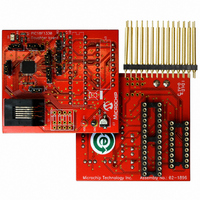AC162078 Microchip Technology, AC162078 Datasheet - Page 54

AC162078
Manufacturer Part Number
AC162078
Description
HEADER INTRFC MPLAB ICD2 18F1330
Manufacturer
Microchip Technology
Datasheet
1.AC162078.pdf
(318 pages)
Specifications of AC162078
Accessory Type
Transition Header
Lead Free Status / RoHS Status
Not applicable / Not applicable
For Use With/related Products
ICD2
Lead Free Status / RoHS Status
Lead free / RoHS Compliant, Not applicable / Not applicable
Available stocks
Company
Part Number
Manufacturer
Quantity
Price
Company:
Part Number:
AC162078
Manufacturer:
MICROCHIP
Quantity:
12 000
- Current page: 54 of 318
- Download datasheet (3Mb)
PIC18F1230/1330
6.1.2.4
Device Resets on stack overflow and stack underflow
conditions are enabled by setting the STVREN bit in
Configuration Register 4L. When STVREN is set, a full
or underflow will set the appropriate STKFUL or
STKUNF bit and then cause a device Reset. When
STVREN is cleared, a full or underflow condition will set
the appropriate STKFUL or STKUNF bit but not cause
a device Reset. The STKFUL or STKUNF bit is cleared
by the user software or a Power-on Reset.
6.1.3
A Fast Register Stack is provided for the STATUS,
WREG and BSR registers, to provide a “fast return”
option for interrupts. The stack for each register is only
one level deep and is neither readable nor writable. It is
loaded with the current value of the corresponding
register when the processor vectors for an interrupt. All
interrupt sources will push values into the Stack
registers. The values in the registers are then loaded
back
RETFIE, FAST instruction is used to return from the
interrupt.
If both low and high-priority interrupts are enabled, the
Stack registers cannot be used reliably to return from
low-priority interrupts. If a high-priority interrupt occurs
while servicing a low-priority interrupt, the Stack regis-
ter values stored by the low-priority interrupt will be
overwritten. In these cases, users must save the key
registers in software during a low-priority interrupt.
If interrupt priority is not used, all interrupts may use the
Fast Register Stack for returns from interrupt. If no
interrupts are used, the Fast Register Stack can be
used to restore the STATUS, WREG and BSR regis-
ters at the end of a subroutine call. To use the Fast
Register Stack for a subroutine call, a CALL
label, FAST instruction must be executed to save the
STATUS, WREG and BSR registers to the Fast Regis-
ter Stack. A RETURN, FAST instruction is then exe-
cuted to restore these registers from the Fast Register
Stack.
Example 6-1 shows a source code example that uses
the Fast Register Stack during a subroutine call and
return.
EXAMPLE 6-1:
DS39758D-page 54
CALL SUB1, FAST
SUB1
into
RETURN, FAST
FAST REGISTER STACK
Stack Full and Underflow Resets
their
associated
FAST REGISTER STACK
CODE EXAMPLE
;STATUS, WREG, BSR
;SAVED IN FAST REGISTER
;STACK
;RESTORE VALUES SAVED
;IN FAST REGISTER STACK
registers
if
the
6.1.4
There may be programming situations that require the
creation of data structures, or look-up tables, in
program memory. For PIC18 devices, look-up tables
can be implemented in two ways:
• Computed GOTO
• Table Reads
6.1.4.1
A computed GOTO is accomplished by adding an offset
to the program counter. An example is shown in
Example 6-2.
A look-up table can be formed with an ADDWF PCL
instruction and a group of RETLW nn instructions. The
W register is loaded with an offset into the table before
executing a call to that table. The first instruction of the
called routine is the ADDWF PCL instruction. The next
instruction executed will be one of the RETLW nn
instructions that returns the value ‘nn’ to the calling
function.
The offset value (in WREG) specifies the number of
bytes that the program counter should advance and
should be multiples of 2 (LSb = 0).
In this method, only one data byte may be stored in
each instruction location and room on the return
address stack is required.
EXAMPLE 6-2:
6.1.4.2
A better method of storing data in program memory
allows two bytes of data to be stored in each instruction
location.
Look-up table data may be stored two bytes per
program word by using table reads and writes. The
Table Pointer (TBLPTR) register specifies the byte
address and the Table Latch (TABLAT) register
contains the data that is read from or written to program
memory. Data is transferred to or from program
memory one byte at a time.
Table read and table write operations are discussed
further in Section 7.1 “Table Reads and Table
Writes”.
ORG
TABLE
MOVF
CALL
nn00h
ADDWF
RETLW
RETLW
RETLW
.
.
.
LOOK-UP TABLES IN PROGRAM
MEMORY
Computed GOTO
Table Reads and Table Writes
OFFSET, W
TABLE
PCL
nnh
nnh
nnh
COMPUTED GOTO USING
AN OFFSET VALUE
2009 Microchip Technology Inc.
Related parts for AC162078
Image
Part Number
Description
Manufacturer
Datasheet
Request
R

Part Number:
Description:
Manufacturer:
Microchip Technology Inc.
Datasheet:

Part Number:
Description:
Manufacturer:
Microchip Technology Inc.
Datasheet:

Part Number:
Description:
Manufacturer:
Microchip Technology Inc.
Datasheet:

Part Number:
Description:
Manufacturer:
Microchip Technology Inc.
Datasheet:

Part Number:
Description:
Manufacturer:
Microchip Technology Inc.
Datasheet:

Part Number:
Description:
Manufacturer:
Microchip Technology Inc.
Datasheet:

Part Number:
Description:
Manufacturer:
Microchip Technology Inc.
Datasheet:

Part Number:
Description:
Manufacturer:
Microchip Technology Inc.
Datasheet:











